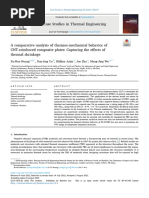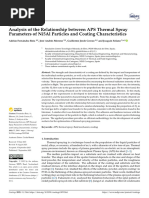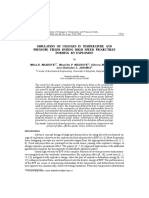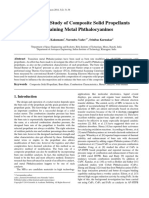702 6
702 6
Uploaded by
anneshanmitraraoCopyright:
Available Formats
702 6
702 6
Uploaded by
anneshanmitraraoOriginal Title
Copyright
Available Formats
Share this document
Did you find this document useful?
Is this content inappropriate?
Copyright:
Available Formats
702 6
702 6
Uploaded by
anneshanmitraraoCopyright:
Available Formats
Anneshan Mitra Rao
Summary Revision
Monday, October 21, 2024
Original-
The article "Kinetic Analysis of the Thermal Decomposition of a Carbon Fibre-Reinforced
Epoxy Resin Laminate" focuses on understanding the thermal behavior of a carbon fiber-
reinforced epoxy composite used in aeronautical structures. The composite in question,
T700/M21, undergoes thermal decomposition, which is analyzed using thermogravimetric (TG)
experiments coupled with Fourier Transform Infrared (FTIR) spectroscopy and numerical
modeling tools. This study aims to determine a comprehensive decomposition model by
combining experimental data with thermokinetic analysis.
The research reveals that the thermal decomposition of the composite occurs through multiple
competitive reactions, including both nth-order and autocatalytic processes. By analyzing the
decomposition gases and their release patterns, the study identifies the main gases produced and
develops a kinetic model to predict the composite's behavior under different thermal conditions.
The findings are crucial for improving fire modeling in aeronautical applications, where accurate
thermal analysis of structural materials is essential for safety and performance optimization.
Revised –
In the article "Kinetic Analysis of the Thermal Decomposition of a Carbon Fibre-Reinforced
Epoxy Resin Laminate," François Tranchard, Philippe Lopez-Cuesta, Christian Ferriol, Aurélien
Samyn, and Jean-Luc Gardette examine the thermal decomposition process of the T700/M21
carbon fiber-reinforced epoxy composite, a material widely used in the aerospace industry. The
study aims to enhance understanding of the composite’s thermal stability under high-temperature
conditions by using thermogravimetric analysis (TG) and Fourier Transform Infrared (FTIR)
spectroscopy to investigate the gases emitted during decomposition. Tranchard et al. focus on
identifying key gases such as carbon dioxide, carbon monoxide, and sulfur dioxide. By
integrating these data with the NETZSCH Thermokinetics software, the authors construct a
kinetic model that explains the material's decomposition through competitive nth-order and
autocatalytic reactions.
Their findings demonstrate that the developed kinetic model accurately predicts the composite’s
behavior in both inert and oxidative environments, which is critical for improving fire safety and
material performance in aerospace applications. The research has broad implications for fire
safety modeling, and Tranchard et al. argue that these findings will enhance the design and safety
measures for aeronautical materials.
Article Link-
https://www.sciencedirect.com/science/article/pii/S0165237017304163
You might also like
- Education Report MENADocument66 pagesEducation Report MENAMohamed HeshamNo ratings yet
- CreditCardStatement PDFDocument4 pagesCreditCardStatement PDFAravind SunithaNo ratings yet
- 702 5Document1 page702 5anneshanmitraraoNo ratings yet
- Pstruct 2019 111221Document35 pagesPstruct 2019 111221atul bhagatNo ratings yet
- Experimental Study and Thermal Characterization of Phase Change Composite MaterialDocument10 pagesExperimental Study and Thermal Characterization of Phase Change Composite MaterialTJPRC PublicationsNo ratings yet
- AN EXPERIMENTAL INVESTIGATION AND VALIDATION OF THERMO-ELASTIC MODELS ON THERMAL CONDUCTIVITY BEHAVIOUR OF Al 6061-SILICON CARBIDE-GRAPHITE HYBRID METAL MATRIX COMPOSITESDocument15 pagesAN EXPERIMENTAL INVESTIGATION AND VALIDATION OF THERMO-ELASTIC MODELS ON THERMAL CONDUCTIVITY BEHAVIOUR OF Al 6061-SILICON CARBIDE-GRAPHITE HYBRID METAL MATRIX COMPOSITESijsretNo ratings yet
- A Comparative Analysis of Thermos Mechanical Behavior of - 2022 - Case Studies IDocument14 pagesA Comparative Analysis of Thermos Mechanical Behavior of - 2022 - Case Studies ICad TutorNo ratings yet
- 2018 Grabowski Et Al. - Anisotropy of Thermal Expansion of 3Y-TZP, α-Al2O3 and Composites From 3Y-TZP - α-Al 2 O 3 SystemDocument10 pages2018 Grabowski Et Al. - Anisotropy of Thermal Expansion of 3Y-TZP, α-Al2O3 and Composites From 3Y-TZP - α-Al 2 O 3 Systemnorthpole_plNo ratings yet
- Lifetime Prediction of Thermo-Mechanical Fatigue For Exhaust ManifoldDocument10 pagesLifetime Prediction of Thermo-Mechanical Fatigue For Exhaust Manifoldram shyamNo ratings yet
- A Review of Numerical and Experimental Characterization of Thermal-1Document51 pagesA Review of Numerical and Experimental Characterization of Thermal-1sivan_nk100% (2)
- Determination of Thermal Conductivity of Polymer Composites Filled With Solid Glass BeadsDocument12 pagesDetermination of Thermal Conductivity of Polymer Composites Filled With Solid Glass Beadsbishnu ppNo ratings yet
- Analysis of The Relationship Between APS Thermal SDocument15 pagesAnalysis of The Relationship Between APS Thermal ScpucheNo ratings yet
- Integrated Fire Dynamic and Thermomechanical Modeling of A Bridge Under FireDocument15 pagesIntegrated Fire Dynamic and Thermomechanical Modeling of A Bridge Under FirerashmiNo ratings yet
- Paper Interim RifkiDocument15 pagesPaper Interim RifkiAlfian RamadhanNo ratings yet
- Fire Safety Journal: Fabien Hermouet, Thomas Rogaume, Eric Guillaume, Franck Richard, Damien Marquis, Xavier PonticqDocument17 pagesFire Safety Journal: Fabien Hermouet, Thomas Rogaume, Eric Guillaume, Franck Richard, Damien Marquis, Xavier PonticqMuhammad AdilNo ratings yet
- Resuspension New 11 05 2022 MJDocument26 pagesResuspension New 11 05 2022 MJmanishNo ratings yet
- Design and CFD Analysis of Combustion Chamber in IDocument10 pagesDesign and CFD Analysis of Combustion Chamber in IRuvimboNo ratings yet
- San Thermal PropertiespdfDocument7 pagesSan Thermal Propertiespdfsukhabhukha987No ratings yet
- Thermal Characteristics of Light Rail Transit Friction MaterialsDocument18 pagesThermal Characteristics of Light Rail Transit Friction MaterialsM.nor ainNo ratings yet
- Case Studies in Thermal Engineering: SciencedirectDocument12 pagesCase Studies in Thermal Engineering: SciencedirecthakeemniyasNo ratings yet
- 1-s2.0-S1359431116319044-mainDocument13 pages1-s2.0-S1359431116319044-maindylan.cadfemvnNo ratings yet
- Simulation Methodology For Coupled Fire-Structure Analysis:: Modeling Localized Fire Tests On A Steel ColumnDocument34 pagesSimulation Methodology For Coupled Fire-Structure Analysis:: Modeling Localized Fire Tests On A Steel ColumnFrank EbingNo ratings yet
- Catalytic Effect of Lead Oxide Nano-And Microparticles On Thermal Decomposition Kinetics of Energetic Compositions Containing Tegdn/Nc/DagDocument12 pagesCatalytic Effect of Lead Oxide Nano-And Microparticles On Thermal Decomposition Kinetics of Energetic Compositions Containing Tegdn/Nc/DagSabri AeroChemNo ratings yet
- Chapter 1-3Document41 pagesChapter 1-3Aaqib IqbalNo ratings yet
- Two-Material Topology Optimization For The Design of Passive Thermal Control StructuresDocument12 pagesTwo-Material Topology Optimization For The Design of Passive Thermal Control StructuresChandrakiran AlapatiNo ratings yet
- KolipDocument11 pagesKolipsouki1No ratings yet
- Paper Publication 2Document7 pagesPaper Publication 2Muhammad R. AbbasNo ratings yet
- Fire Safety Journal: Julio Cesar G. Silva, Alexandre Landesmann, Fernando Luiz B. RibeiroDocument13 pagesFire Safety Journal: Julio Cesar G. Silva, Alexandre Landesmann, Fernando Luiz B. RibeiroSun RuiNo ratings yet
- Simplified Thermal Analysis of Reinforced Concrete Fuel Storage Tanks Exposed To FireDocument10 pagesSimplified Thermal Analysis of Reinforced Concrete Fuel Storage Tanks Exposed To FireMiguel Renato Manco Rivera100% (1)
- Jsaer2016 03 04 41 49Document9 pagesJsaer2016 03 04 41 49jsaereditorNo ratings yet
- Harmonic Response Analysis of An Impeller of A Gas Turbine Engine Which Modelled by Using High Entropy Alloy MaterialsDocument14 pagesHarmonic Response Analysis of An Impeller of A Gas Turbine Engine Which Modelled by Using High Entropy Alloy Materials白啟正No ratings yet
- Simulation of Changes in Temperature and Pressure Fields During High Speed Projectiles Forming by ExplosionDocument12 pagesSimulation of Changes in Temperature and Pressure Fields During High Speed Projectiles Forming by ExplosionDani SaadNo ratings yet
- Analysis of Blunt Nose Cone With Ultra High Temperature Ceramic Composite TPS MaterialsDocument7 pagesAnalysis of Blunt Nose Cone With Ultra High Temperature Ceramic Composite TPS MaterialsmegustalazorraNo ratings yet
- 702 3Document2 pages702 3anneshanmitraraoNo ratings yet
- International Journal of Engineering Research and Development (IJERD)Document6 pagesInternational Journal of Engineering Research and Development (IJERD)IJERDNo ratings yet
- Comparative Study On Heat Transfer Performance of Al2O3 - 2022 - Case StudiesDocument23 pagesComparative Study On Heat Transfer Performance of Al2O3 - 2022 - Case StudiesCad TutorNo ratings yet
- Intern 1 PDFDocument5 pagesIntern 1 PDFintan arumNo ratings yet
- Mid Rex 7Document22 pagesMid Rex 7Sudeshna RoyNo ratings yet
- F 214758129631110Document13 pagesF 214758129631110Engineer SohaibNo ratings yet
- Flame SynthesisDocument9 pagesFlame Synthesisre453856No ratings yet
- Exergy Analysis of A Flat Plate Solar Collector With Latent Heat Storage by Phase Change Material For Water Heating Applications at Low TemperatureDocument6 pagesExergy Analysis of A Flat Plate Solar Collector With Latent Heat Storage by Phase Change Material For Water Heating Applications at Low TemperatureJournal of Contemporary Urban AffairsNo ratings yet
- Materials and Design: Amar Patnaik, MD Abdulla, Alok Satapathy, Sandhyarani Biswas, Bhabani K. SatapathyDocument13 pagesMaterials and Design: Amar Patnaik, MD Abdulla, Alok Satapathy, Sandhyarani Biswas, Bhabani K. Satapathybishnu ppNo ratings yet
- Analysis and Comparative Assessment of Basic Tribological Properties of Selected Polymer Composites _2279Document24 pagesAnalysis and Comparative Assessment of Basic Tribological Properties of Selected Polymer Composites _2279managerNo ratings yet
- ENC-2024-0441Document8 pagesENC-2024-0441Raphael EspindolaNo ratings yet
- Combustion Study of Composite Solid Propellants Containing Metal PhthalocyaninesDocument6 pagesCombustion Study of Composite Solid Propellants Containing Metal PhthalocyaninesVladimir BukaricaNo ratings yet
- 1-s2.0-S0165237017308781-mainDocument7 pages1-s2.0-S0165237017308781-mainMadiha RashidNo ratings yet
- Thermal Barrier Coating in ANSYSDocument10 pagesThermal Barrier Coating in ANSYSchandruNo ratings yet
- Prediction of Thermal Fatigue Life of A Turbine Nozzle Guide VaneDocument9 pagesPrediction of Thermal Fatigue Life of A Turbine Nozzle Guide VanejswxieNo ratings yet
- Experimental Investigation To Improve Flame Intensity in 250MW Tangentially Firing FurnaceDocument11 pagesExperimental Investigation To Improve Flame Intensity in 250MW Tangentially Firing FurnaceSiddhant SatpathyNo ratings yet
- Tatb HMX PBXDocument11 pagesTatb HMX PBXwyngo68No ratings yet
- Neki DokDocument11 pagesNeki DokMostarchinaNo ratings yet
- Jens Rocks ThesisDocument200 pagesJens Rocks ThesisNano MaxNo ratings yet
- Fire Resistance of CFRPDocument21 pagesFire Resistance of CFRPPraveen JainNo ratings yet
- Motor PlumeDocument17 pagesMotor PlumeTahir Rashid100% (1)
- Welding Process Simulation Model For Temperature and Residual Stress AnalysisDocument8 pagesWelding Process Simulation Model For Temperature and Residual Stress AnalysisOmar MasmoudiNo ratings yet
- Numerical Investigation of NOx Reduction in A Hydrogen-Fueled Pulse Detonation EngineDocument12 pagesNumerical Investigation of NOx Reduction in A Hydrogen-Fueled Pulse Detonation EngineSayed Ahmed ImranNo ratings yet
- PMMA CharacterizationDocument11 pagesPMMA Characterization233891No ratings yet
- A Simulation Study On Thermal Conductivity of Glass Bead Embedded Polymeric SystemDocument15 pagesA Simulation Study On Thermal Conductivity of Glass Bead Embedded Polymeric Systembishnu ppNo ratings yet
- Heterogeneous Catalysis - An Interdisciplinary ApproachDocument5 pagesHeterogeneous Catalysis - An Interdisciplinary ApproachCesar MarquezNo ratings yet
- Ceramic Coatings For High Temperature Environments From Thermal-2024Document493 pagesCeramic Coatings For High Temperature Environments From Thermal-2024Bunner FastNo ratings yet
- pelin2018Document9 pagespelin2018spacefieldsteamNo ratings yet
- Thermal Conductivity Measurements in Atomically Thin Materials and DevicesFrom EverandThermal Conductivity Measurements in Atomically Thin Materials and DevicesNo ratings yet
- Humaclot JuniorDocument40 pagesHumaclot JuniorJonatan Rolong Ibáñez100% (3)
- Steel Master 1200 WF PDSDocument5 pagesSteel Master 1200 WF PDSshameelNo ratings yet
- Implementation of A Full AdderDocument2 pagesImplementation of A Full AdderRebeca CuNo ratings yet
- Chapter 18 - Gripping IFRS ICAP 2008 (Solution of Graded Questions)Document10 pagesChapter 18 - Gripping IFRS ICAP 2008 (Solution of Graded Questions)Falah Ud Din SheryarNo ratings yet
- Lesson 35: Working Capital Management: Learning ObjectivesDocument5 pagesLesson 35: Working Capital Management: Learning ObjectivesmuneerppNo ratings yet
- Forward Rate AgreementDocument3 pagesForward Rate AgreementmeetwithsanjayNo ratings yet
- Macro Tutor2u ADocument18 pagesMacro Tutor2u AdNo ratings yet
- Outline and Explain TWO Ethical Issues That Sociologists Using Primary Quantitative Methods Would - StudocuDocument1 pageOutline and Explain TWO Ethical Issues That Sociologists Using Primary Quantitative Methods Would - Studocusiennajaslee08No ratings yet
- Main NotesDocument227 pagesMain NotesNguyễn Minh HiếuNo ratings yet
- Black and White Chalkboard Brainstorm Presentation - 20240822 - 143735 - 0000Document6 pagesBlack and White Chalkboard Brainstorm Presentation - 20240822 - 143735 - 0000mpsaj1220a9No ratings yet
- BQS502 Lecture Schedule October 2022 - February 2023 RM V3Document3 pagesBQS502 Lecture Schedule October 2022 - February 2023 RM V3李宛妲No ratings yet
- TrueMe ReportDocument9 pagesTrueMe ReportErika ClaggNo ratings yet
- Definition of Stock ExchangeDocument21 pagesDefinition of Stock ExchangeSrinu UdumulaNo ratings yet
- Hif 18031Document293 pagesHif 18031Manuel MirandaNo ratings yet
- Project On Mutual FundDocument109 pagesProject On Mutual FundPrajwal AlvaNo ratings yet
- National Strategic Framework For HIV and AIDS Response in Namibia 2010/11 - 2015/16Document144 pagesNational Strategic Framework For HIV and AIDS Response in Namibia 2010/11 - 2015/16Laura Lopez GonzalezNo ratings yet
- 1.0 Two Lists (Discipline-Wise) Enclosed:: 1.1 Merit ListDocument7 pages1.0 Two Lists (Discipline-Wise) Enclosed:: 1.1 Merit ListAngel SnaNo ratings yet
- Bank Online Deposit: Pakistan Mint Lahore Govt of PakistanDocument3 pagesBank Online Deposit: Pakistan Mint Lahore Govt of PakistanAh BhNo ratings yet
- October 2023 Unicef Templete Report FinalDocument18 pagesOctober 2023 Unicef Templete Report FinaltdsaungwemeNo ratings yet
- ECO-E64WX All-In-One Air-Cooled Hybrid Solar ESS CabinetDocument2 pagesECO-E64WX All-In-One Air-Cooled Hybrid Solar ESS Cabinetakachuks1No ratings yet
- De-STA-CO 82M-3E Power Clamps CatalogDocument28 pagesDe-STA-CO 82M-3E Power Clamps CatalogDiego ProtonNo ratings yet
- Question Bank-Sustainable Development NP307Document9 pagesQuestion Bank-Sustainable Development NP307Marina SherifNo ratings yet
- BMWDocument41 pagesBMWHugo ParraNo ratings yet
- P+F Inductive SensorDocument2 pagesP+F Inductive Sensorzguy360No ratings yet
- Mobile Shop Project Report PDFDocument5 pagesMobile Shop Project Report PDFDAMN LOOKIN LIKE MONA LISA HOL-UPNo ratings yet
- BULACAN Kia Adrienne ResearchDocument17 pagesBULACAN Kia Adrienne Research308501No ratings yet
- Driver Capy C11G Cnc4pcDocument19 pagesDriver Capy C11G Cnc4pccastellano_rNo ratings yet
- Essential Guide To Chocolate 3Document16 pagesEssential Guide To Chocolate 3Edgar Valderrama100% (1)

























































































